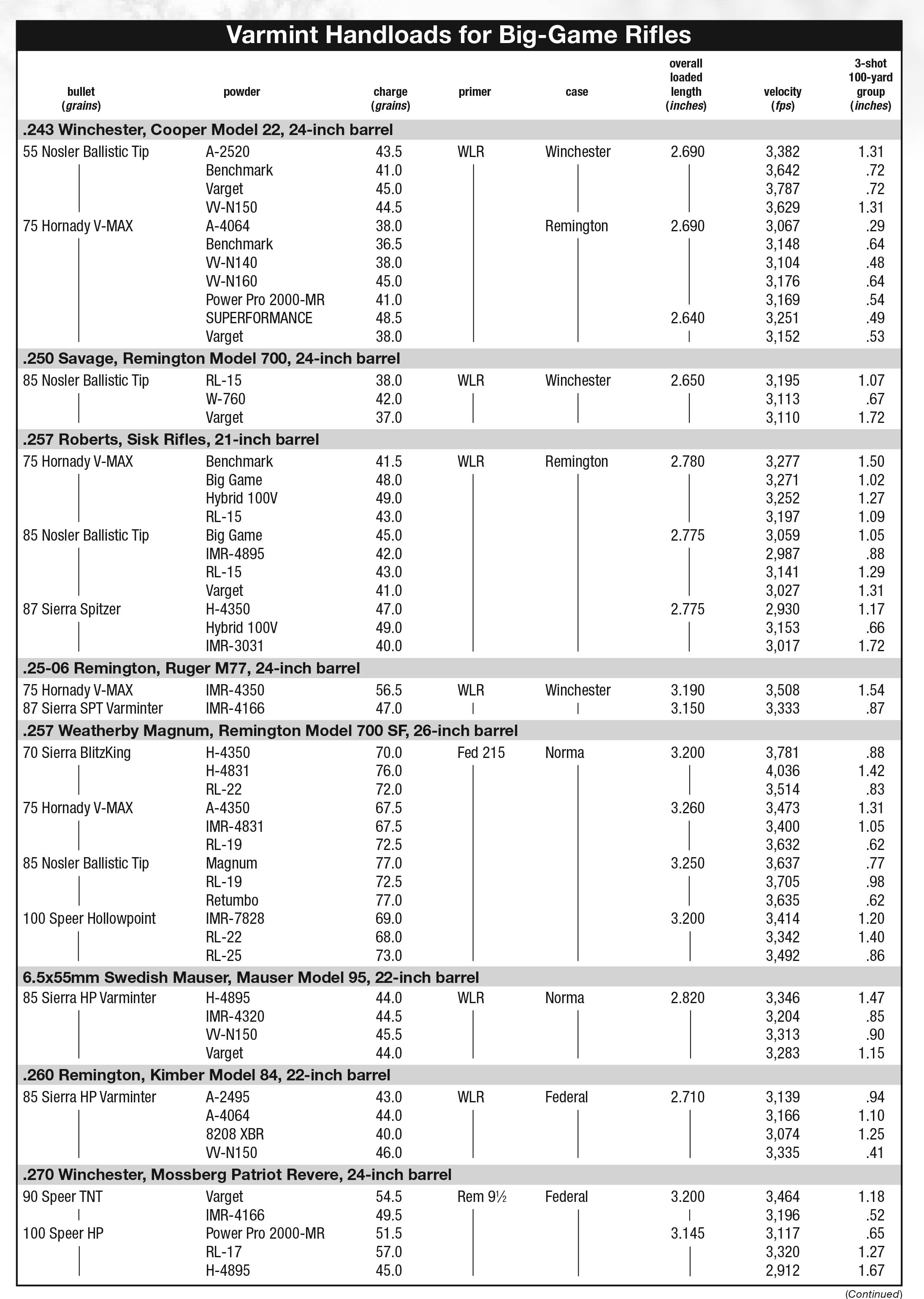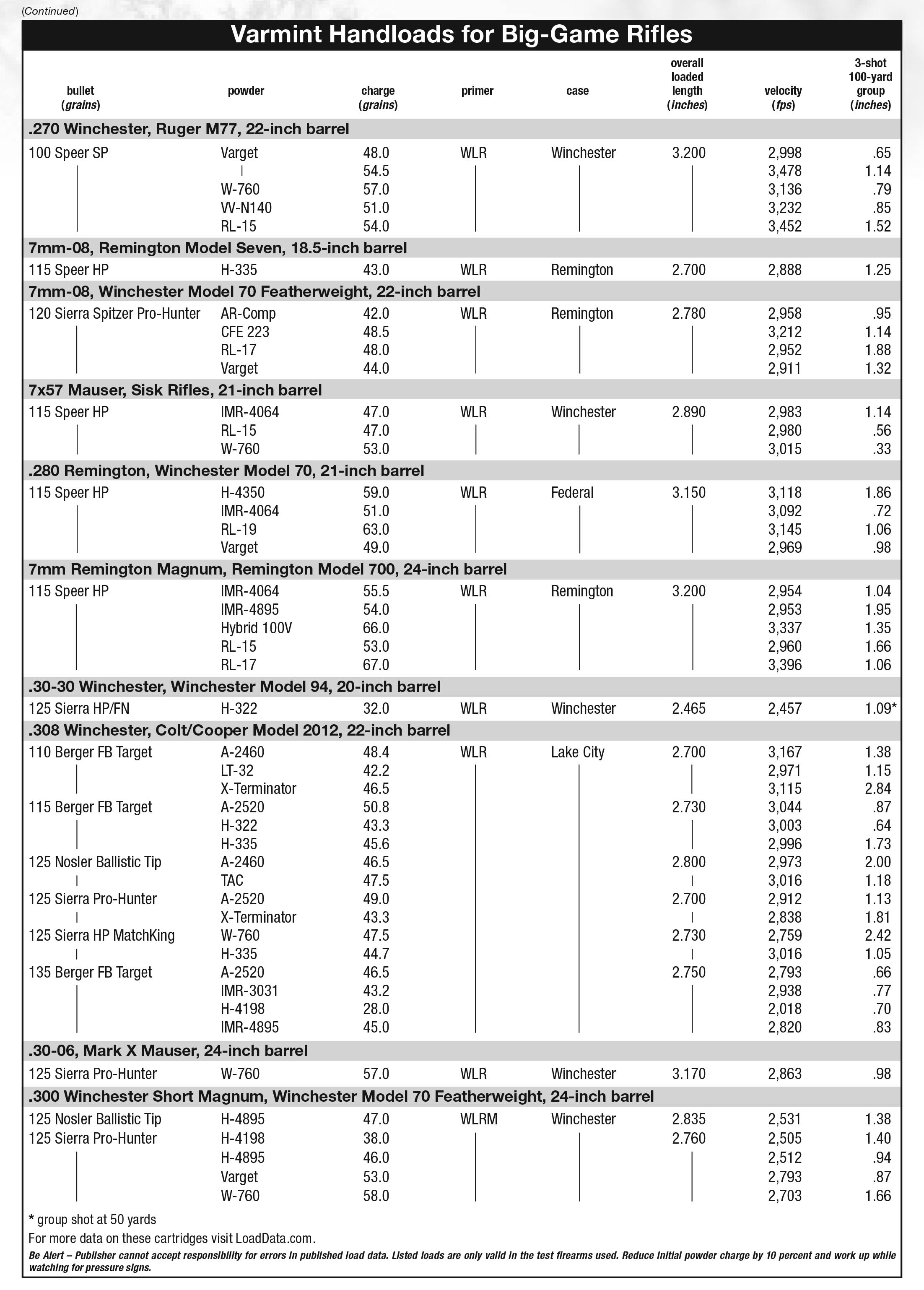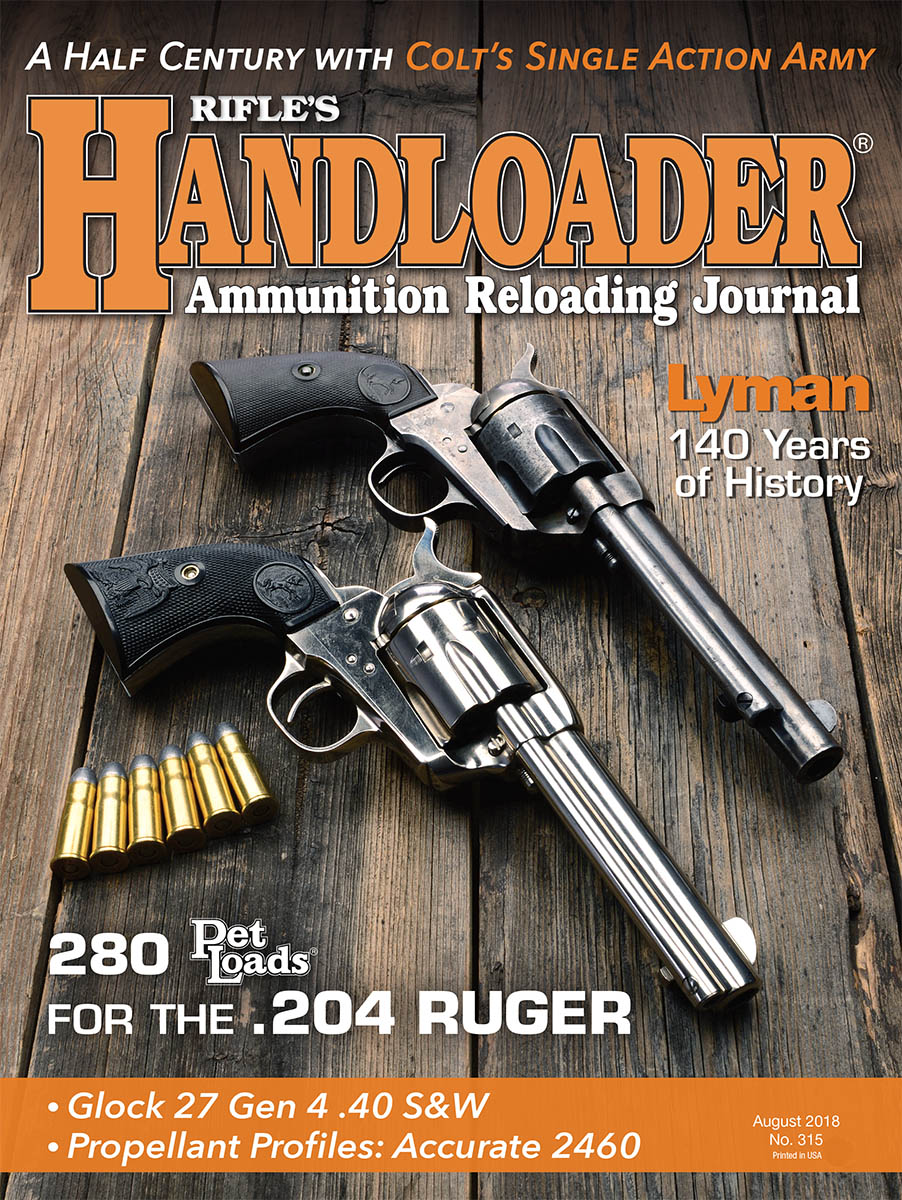Lightweight Bullets for Big-Game Cartridges
Turn your deer rig into an off-season varmint zapper.
feature By: John Haviland | August, 18
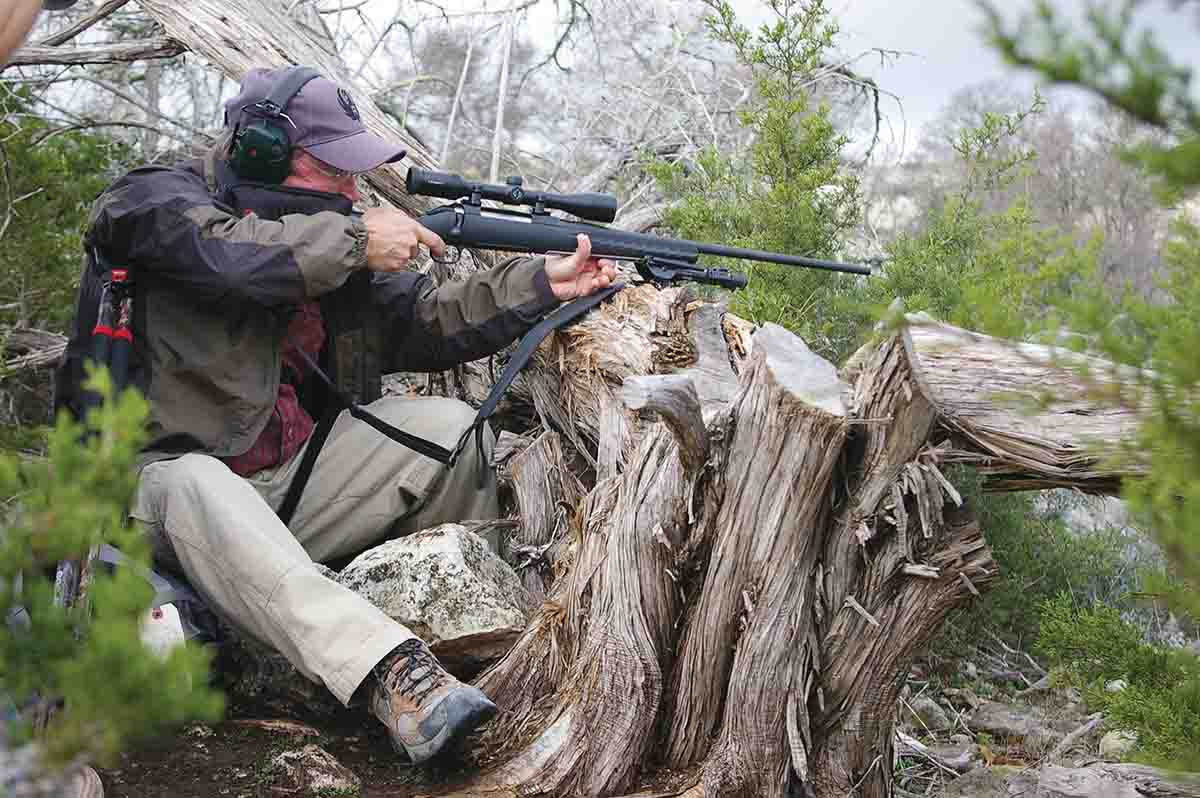
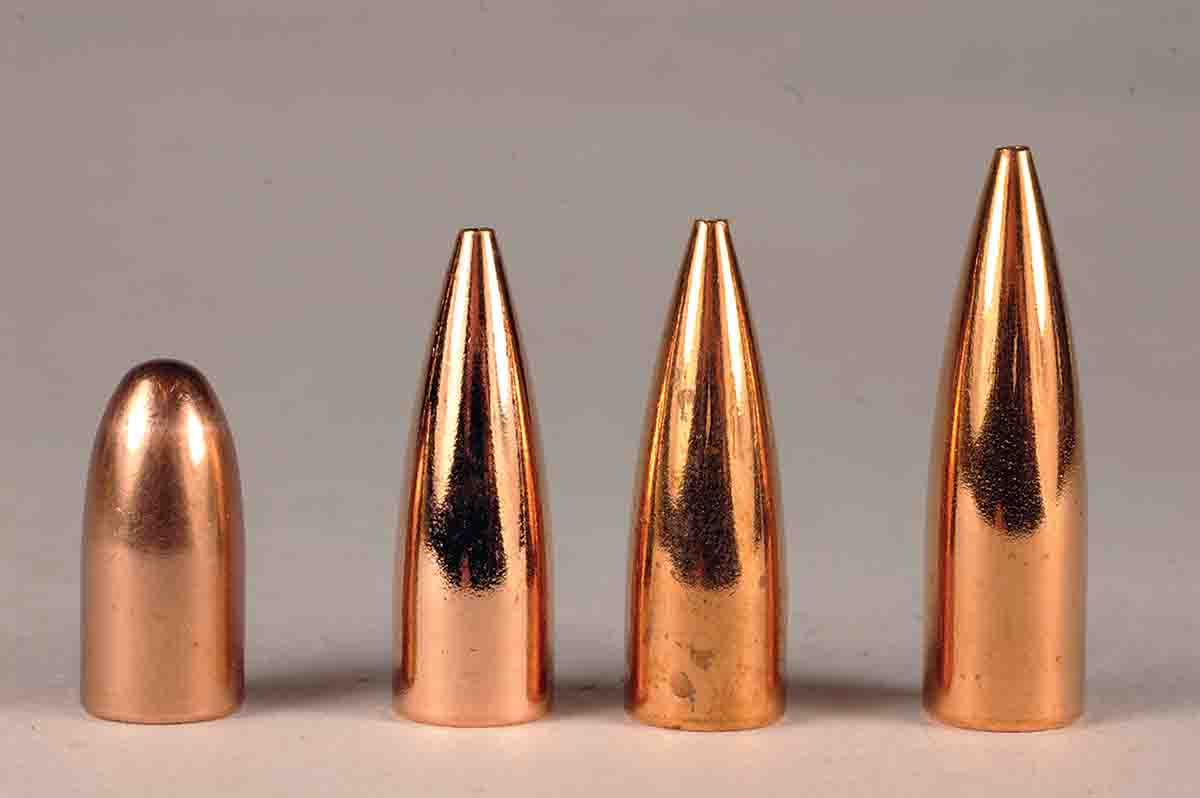
In the years since, I’ve handloaded a lot more cartridges, from the .243 Winchester to various .300 magnums, to hunt varmints and predators. Correct bullet and powder selection is essential to handloading each of those cartridges to provide the best accuracy, and loads are tailored to suit each rifle’s use.
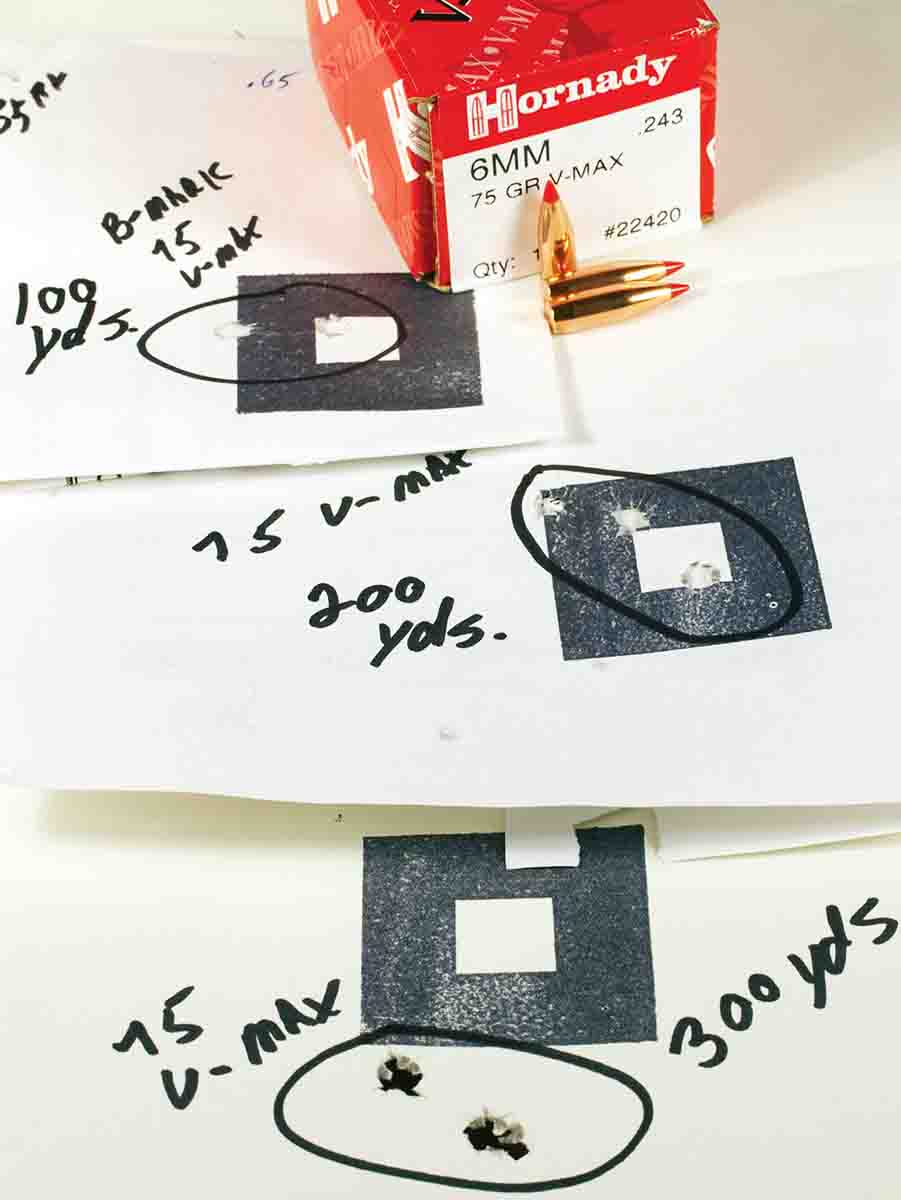
We tend to think lighter-weight bullets are right for shooting varmints with big-game rifles. We’re unconcerned whether bullets retain any portion of their weight when they strike, but rather concerned with their rapid expansion. Lighter bullets also have flatter trajectories because their much faster velocities trump the higher ballistic coefficients (BCs) of heavier bullets. For instance, the .308 Winchester shooting 125-grain spitzer bullets at 3,100 fps drops 3 inches less at 300 yards and 5 inches less at 400 yards than 165-grain spitzer bullets fired at 2,700 fps. The lighter bullet burns a few more grains of powder to reach that high velocity than the heavier bullet. So recoil generated from both loads is about the same.
Comparing the shape of these lighter bullets can result in a flatter trajectory. For instance, Sierra makes two 70-grain .24-caliber bullets. The 70-grain MatchKing features a boat-tail and a hollowpoint with a BC of .259. In contrast, BlitzKing bullets of the same weight are also made with a boat-tail and a pointed plastic tip with a BC of .299. However, the BlitzKing’s slightly higher BC results in about half an inch less drop

Larger caliber bullets are usually made with a flat base. All of Berger’s .30-caliber 110-, 115-, 125-, 135- and 150-grain bullets have a flat base. The taper of these light bullets is best placed toward the front to form an elongated tip to increase their BC. Sierra’s .30-caliber 125-grain Pro-Hunter bullet has a spitzer point and lead tip with a BC of .279. In contrast, Sierra’s 125-grain MatchKing HP has a tapered ogive that ends in a narrow hollowpoint. Its BC is .349, but enough about numbers.
When my oldest son was born, I bought him a Ruger M77 bolt-action .270 Winchester. I
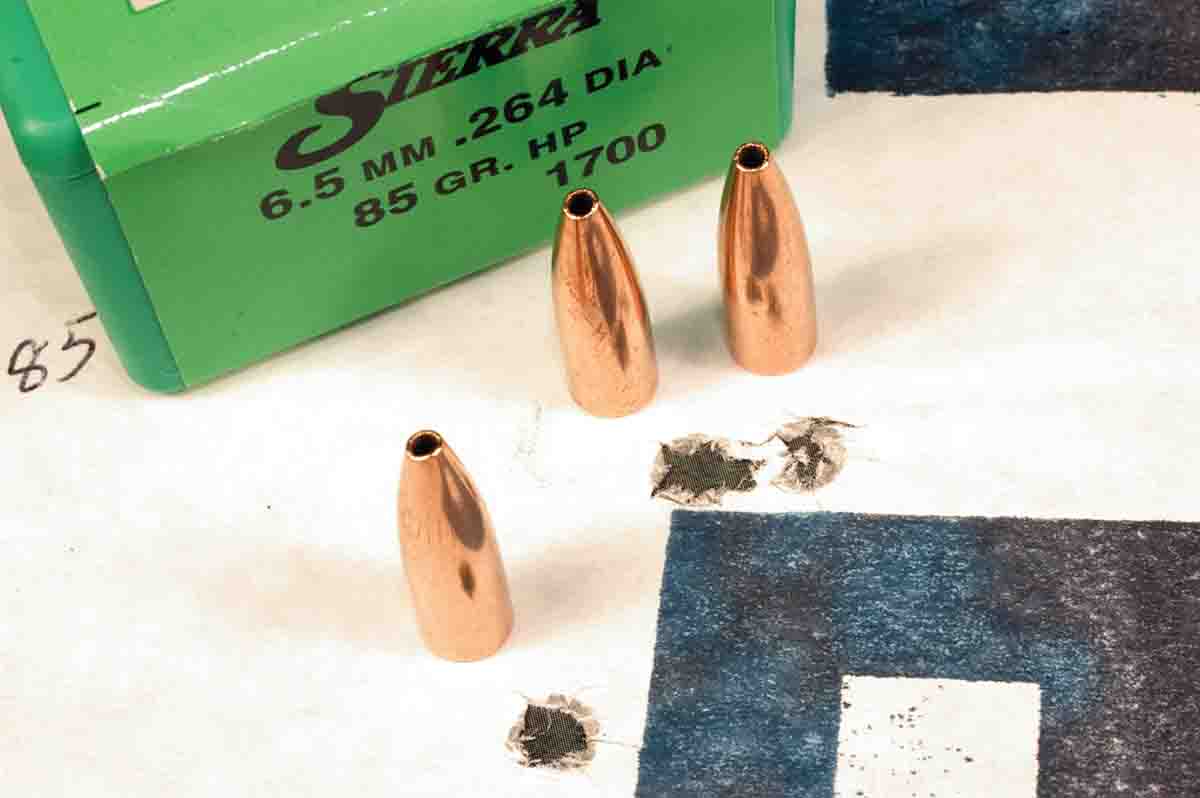
Before Paul’s first few big-game seasons, a batch of .270 cartridges was loaded with Speer 100-grain spitzer bullets at a muzzle velocity close to 3,000 fps. That load created fairly mild recoil, and he fired 10 or 15 shots at ground squirrels each time we went out during the spring and summer. As hunting seasons approached, I stepped up the velocity of the Speer bullets to 3,136 fps by using 57.0 grains of W-760. The 100-grain bullets had close to the same trajectory out to 300 yards as the 130-grain bullets he would shoot when hunting big-game. Recoil was noticeable with his skinny shoulder
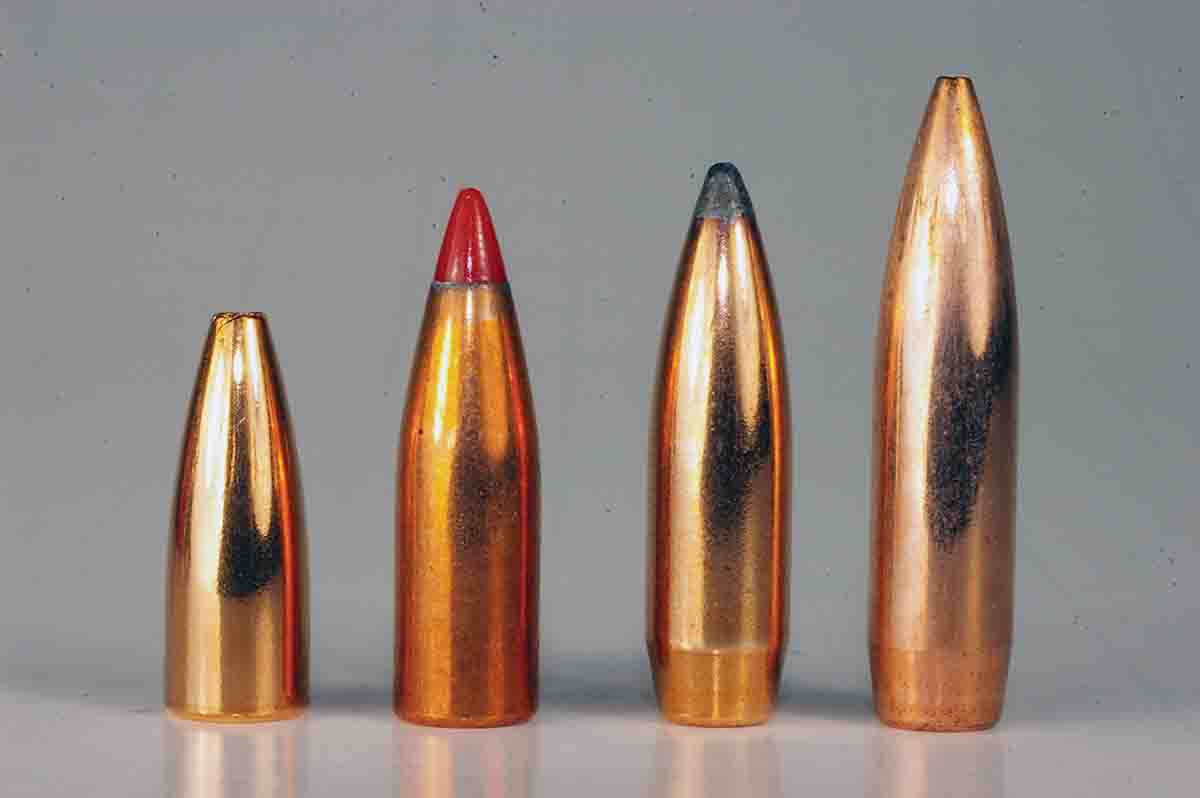
Recently I was developing some handloads for a new Mossberg Patriot Revere .270 Winchester with a 24-inch barrel. The rifle was sighted in for hunting to place full-power loads with 150-grain bullets for hunting big game 2 inches above aim at 100 yards. A mild-recoiling load of 45.0 grains of H-4895 shot Speer 100-grain HP bullets at 2,912 fps, and the bullets hit right on aim at 100 yards. So without touching the rifle’s scope adjustments, this spring I will have a good short-range gopher load for the Patriot rifle.
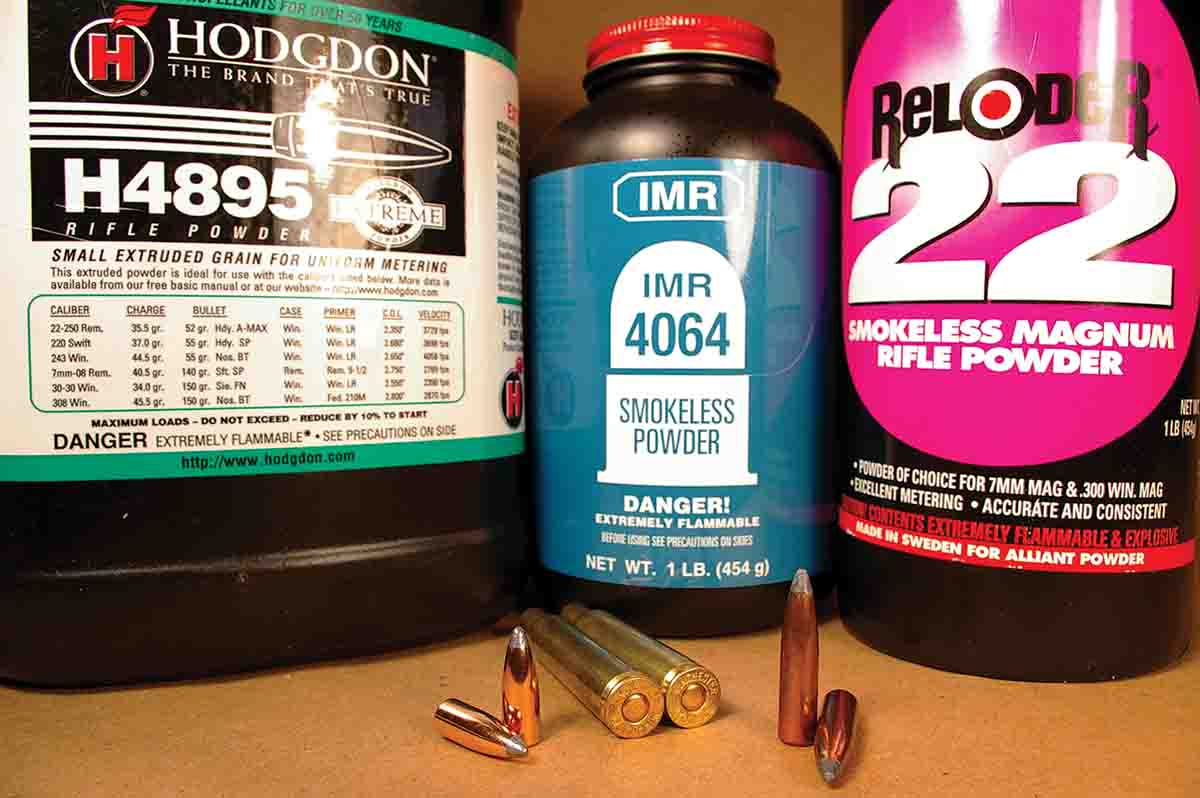
Smaller big-game cartridges, like the .250 Savage, .257 Roberts and .308 Winchester, shoot lighter bullets at upward of maximum velocity to produce even velocities. Extreme velocity spreads are somewhat higher when shooting relatively lightweight bullets in larger cartridges like the 7mm Remington Magnum. For instance, Horn-ady 75-grain V-MAX bullets fired with nearly maximum amounts of Hodgdon Benchmark, Ramshot Big Game, Hybrid 100V and Reloder 15 powders in a .257 Roberts rifle produced extreme velocity spreads of 24 to 37 fps. Conversely, the 7mm Remington Magnum shooting Speer 115-grain bullets at 3,337 fps with 66.0 grains of Hybrid 100V turned in extreme velocity spreads of 76 fps.
All that velocity, though, is wasted in a hunting rifle mounted with a low-power variable scope. My Mossberg MVP .308 Winchester is topped off with a Redfield
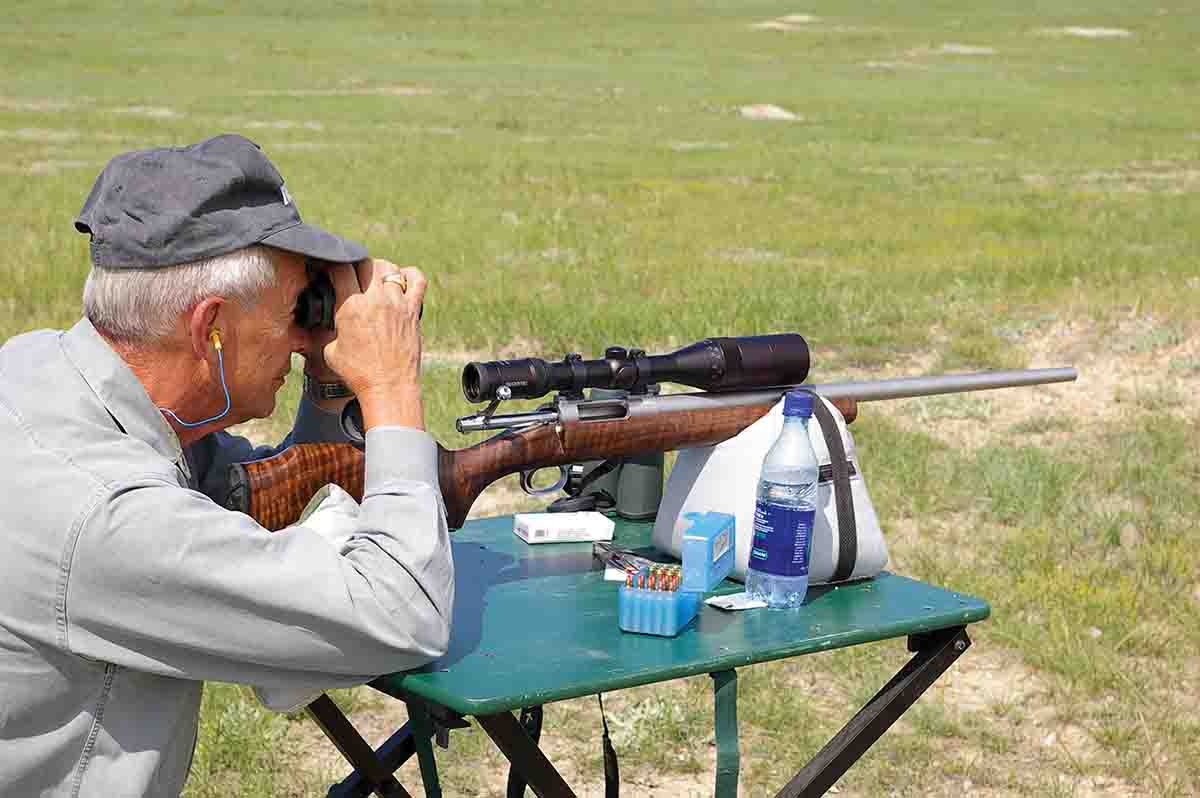
Generally speaking, if a slower velocity is desired, a faster-burning powder should be selected to maintain even velocities. From the .308 Winchester, for example, Berger 135-grain FB Target bullets at 2,800 to 2,900 fps had extreme velocity spreads of 20 and 32 fps when loaded over minimum amounts of IMR-3031 and IMR-4895.
For varmint shooting with the .25-06 Remington out to 250 yards, Nosler 85-grain Ballistic Tip bullets and H-4895 shoot accurately at a reduced velocity of 2,900 fps. Even faster-burning H-4198 shoots the Speer 87-grain bullet well at 2,600 fps. This is because each of these powders deliver the best ballistic performance within a certain pressure range. The faster a powder’s burning rate, the lower the pressure range at which it works best.
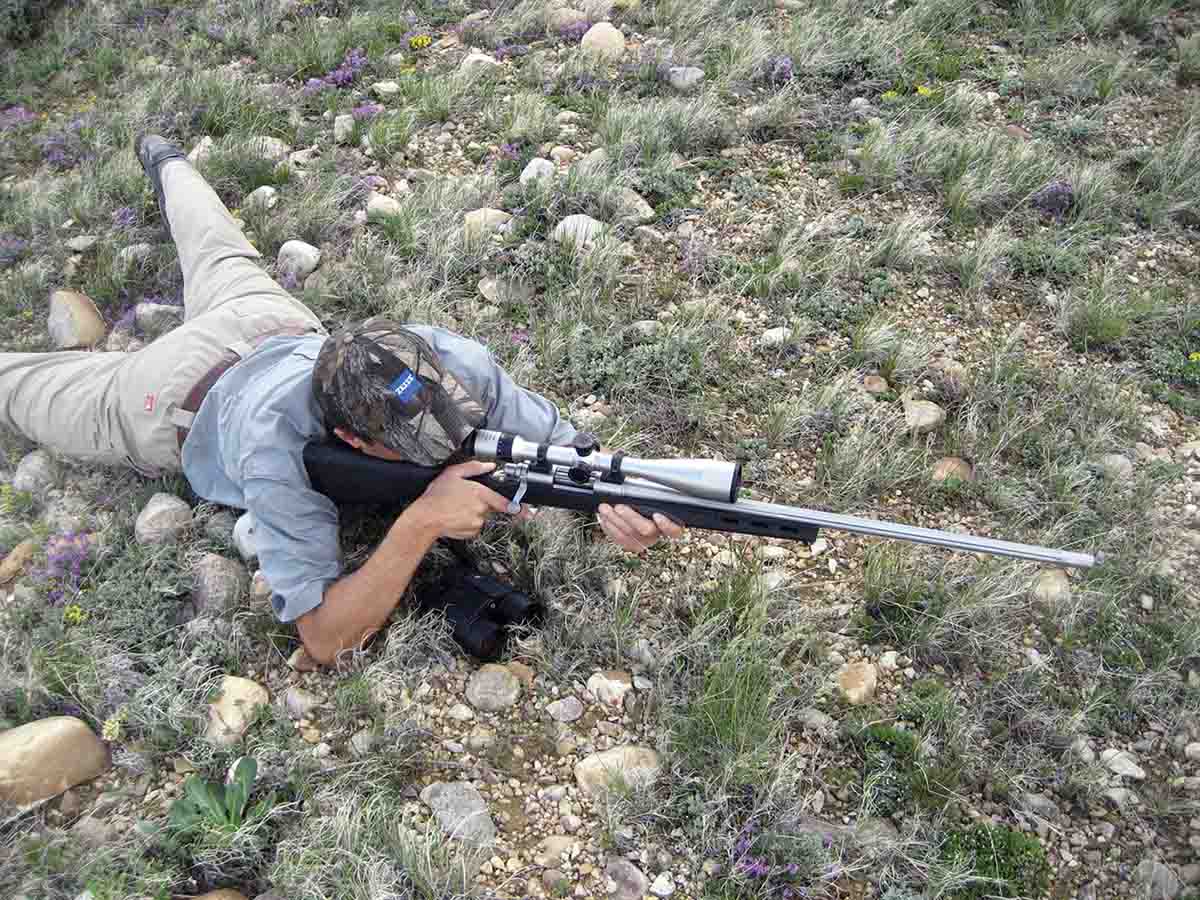
All that shooting will show what works and what needs improving with the rifle and shooter before big-game season opens.
